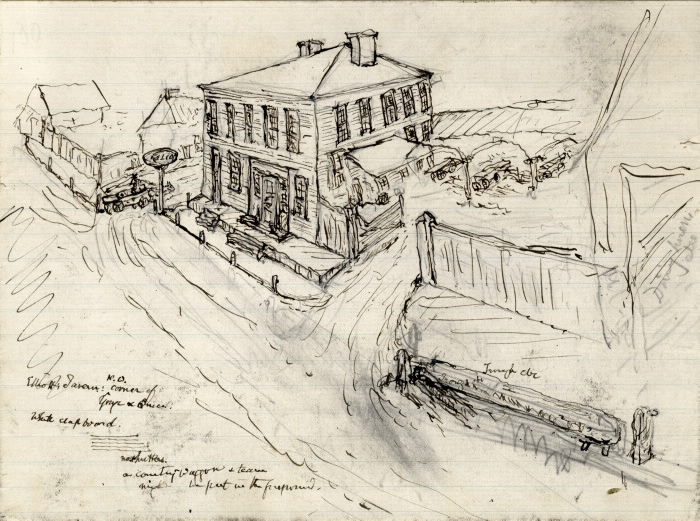
Thomas Hill opened the neighbourhood’s first tavern – near today’s Toyota dealership on Yonge south of Lawrence – in 1811. It was the latest in a string of inns that now peppered the Yonge Street route up to Newmarket and beyond.
There was already a tavern almost within sight of Hill’s to the south, operated by John McDougall. And the widow Valliere had recently opened one down in the hollow to the north (Hogg’s).
Muddy Yonge already had more drinking holes than any other road in Upper Canada. The stump-infested character of the road no doubt contributed to the need to stop for a drink, then stop for another.
Hill originally settled (probably squatted) on the property in 1797. But when the lot was formally granted to someone else, he uprooted his family and headed up Yonge Street to what is now Sheppard Avenue. Hill opened a tavern there, but two years later bought the property he’d left and returned to this area. It was only a matter of time before he decided to open another tavern.
The enterprise was likely little more than a log cabin with a water trough out front for washing and for the horses. Inside, the air was heavy with the smell of stale alcohol and smoke. Whiskey could be purchased for a penny a glass, or five cents for a grunt (the amount a person could drink without taking a breath). Adjoining the barroom was a tiny kitchen.
Most taverns were also inns, so there were likely a few beds in a small loft on the second floor. Travellers would often have to share a bed that boasted planks instead of a mattress. In the summer, there were mosquitoes to contend with. In the winter, the challenge was the sopping wet floor from the snow tracked in on people’s boots.
Drinking wasn’t limited to establishments like Hill’s. It was a rampant reality in many aspects of pioneer life. There was usually a jug of it on the table at every meal. Children grew up drinking whiskey. The men took it with them to the fields. A visitor at the time suggested that those who couldn’t hold their liquor should avoid Canada altogether.
Whiskey, the preferred drink of the working class and farmers, was cheap (25 cents a gallon), readily available and often lethal. Amateurs could – and did – make it at home. It was the octane that ignited building bees – these gatherings were eventually abandoned because the cost of drink and food exceeded the cost of simply bringing in efficient craftsmen.
Alcohol also fueled fights. Many of the assault charges in the early years had their roots in drunken behaviour. A positive side to this was the Stump Act of 1800 that required a convicted drunk to remove a stump from the road. As the drinking got worse, Yonge Street became smoother.
Gary Schlee has been a resident of Bedford Park since 1991. As an author and historian, he has written many articles about the history of our area, notably from 2003-2012, for Community Life published by Fairlawn Avenue United Church (FAUC). This article originally appeared in the Summer 2005 issue. BPRO is grateful to Gary and FAUC for kindly and generously authorizing us to reprint these articles on our website. Please come back regularly to see additional articles as we post them.
